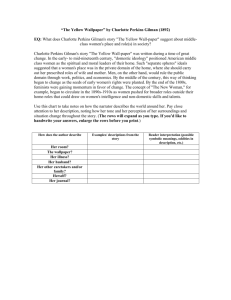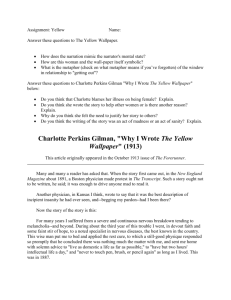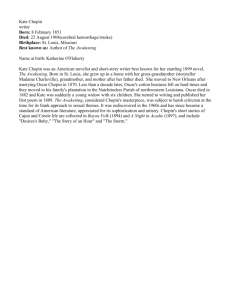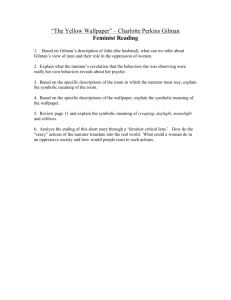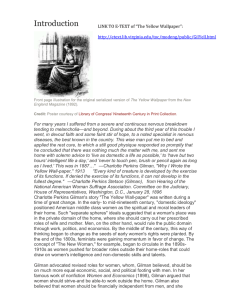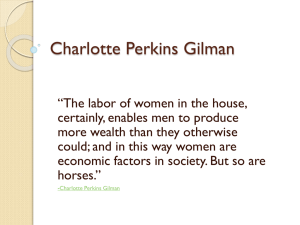American Feminism in Literature (late 1800s)
advertisement
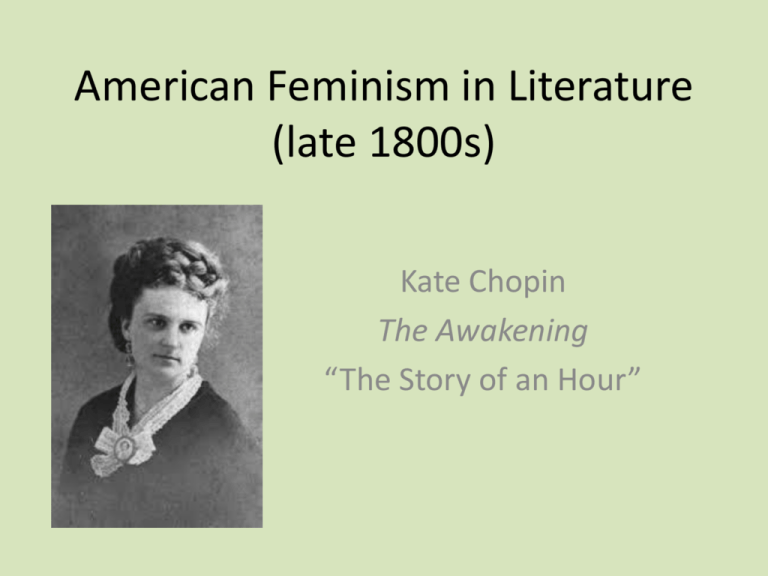
American Feminism in Literature (late 1800s) Kate Chopin The Awakening “The Story of an Hour” Women Know Your Limits Feminism Women break free of the “Romantic” mold that had come to define their gender in popular fiction Instead of female characters fulfilling the secondary roles assigned to them by male authors, women (and their particular struggle) are given center stage and an interior life by a new and emerging group of authors: women While writing in authentic, often local colors, they also portray the universal struggle for female independence—sometimes openly but often quite subtly given the cultural climate Sarah Orne Jewett’s A Country Doctor (1884) lays foundation Kate Chopin’s The Awakening (1899) is a watershed moment Social Norms for Women • Emphasis on female purity • ideal of the "true woman" as wife, mother, and keeper of the home. • the home was the basis of morality and a sanctuary free from the corruption of the city. As guardian of the home and family, women were believed to be more emotional, dependent, and gentle by nature. • This perception of femininity led to the popular conclusion that women were more susceptible to disease and illness, and was a basis for the diagnosis of insanity in many female patients during the 19th century. • Rather than being viewed as a bad and immoral woman, honor and reputation could be maintained by the diagnosis of a medical condition and commitment to an asylum. He Thinks He’ll Keep Her What does it mean to be a “kept woman” • 19th century upper and middle class women were completely dependent on their husbands and fathers, and their lives revolved around their role as respectable daughter, housewife, and mother. • With so little power, control, and independence, depression, anxiety, and stress were common among women struggling to cope with a static existence under the thumb of strict gender ideals and unyielding patriarchy. Those Crazy Ladies Hysteria and Madness • Heredity, environment, gender, class, and 'sinful' behavior were commonly identified as causes of mental illness. • Classification of insanity, treatment methods, and asylum design were based on these same principles. Physicians believed that they could cure patients if they could alter the physical environment by removing a patient from the city, or by stopping a then unacceptable behavior or by surgically removing parts of the body or brain. Not to make light of mental illness • Women did suffer from depression, anxiety, and the likes that in fact are recognized mental illnesses. • However, those who spoke out against their defined roles were often deemed as having a mental problem. • Authors such as Dorothy Parker, Sylvia Plath, Anne Sexton, or Susanna Kaysen all attempted or committed suicide may very well be a reflection of the struggle to break free from gender stereotypes. • Kate Chopin’s Edna Pontellier certainly struggles with breaking free from social norms, those expectations for wife, mother, woman. The Awakening and “The Story of an Hour” • How specifically does Edna rebel against social conventions in The Awakening and “The Story of an Hour? • How does her rebellion manifest specifically? • Which of her actions seem most shocking to her community? • What is the “joy that kills”? • From both works, summarize what is Chopin asserting. Charlotte Perkins Gilman 1860-1935 Born into one of the “great” families of the 19th century “Family” is the problem in both her life and her work Father abandons family and leaves them destitute Mother was cold and unable to show Charlotte affection Charlotte Perkins Gilman 1884: Marries a Bohemian artist who is nevertheless “traditional” in his views on gender 1885: Gives birth to a daughter (her only child) and begins suffering from post-partum depression Visits S. Wier Mitchell—a famous specialist in “hysteria” “The Yellow Wall-paper” (1892) is a psychological and suspenseful tale of isolation and insanity based largely on Gilman’s own experience with the “rest cure” Dr. S. Wier Mitchell Charlotte Perkins Gilman REST CURE Remain in bed for 6 weeks to 2 months No sitting up for the first 4-5 weeks No sewing, writing, reading, or the use of one’s hands other than to clean the teeth Bowels may be passed while lying down Patient may be lifted onto a lounge for an hour in the morning and again at bedtime and then lifted back into a newly made bed “The Yellow Wall-Paper” Written in 1890, but not published until 1892 Told from the point of view of a nameless female protagonist who undergoes the rest cure, in an ancestral home, while on vacation with her husband, who also happens to be a doctor She is there with her baby (whom we never see) and her sisterin-law (who is a helper) She spends all her time in the bedroom (which once was a nursery) and writes (secretively) about her increasing fascination with the strange yellow wallpaper She begins to see odd patterns in it; then to identify with it; and finally to enter into the “fantasy” world it generates Descent into Madness … or Escape into Freedom? From what is the narrator suffering? Why, how, and to whom is she writing? Isolation What is the wallpaper? What does it look like? How does the narrator perceive it? How does it behave? What is the conflict? What is the plot? Fascination>Identification>Transformation Insanity Triumph of Imagination … or Tragedy of Society? Does the room have a history Symbolic? Ironic? Symbolism? Wallpaper? Window? Names? Motif ? Style? Phrases? Descriptions? Style? Sentences? Voice? Plot? Irony of the ending Is she freed by her imagination or trapped inside it? Has she locked others out or locked herself in?
